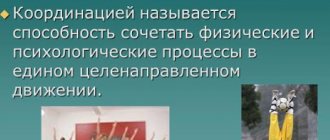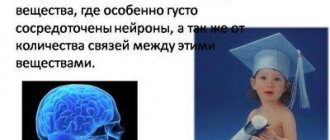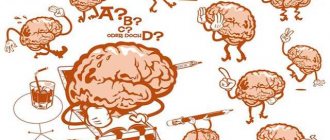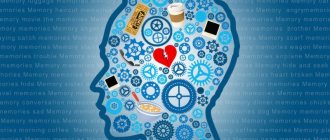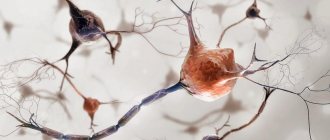The concept of eidetic memory and its development in psychology
Eidetic memory in psychology or eidetism is a special type of thinking in which a person is able to instantly remember various images and then reproduce them.
Eidetic memory in psychology - what is it.
The phenomenon is characterized by visual impression, as well as other sensory modalities:
- taste;
- tactile;
- olfactory;
- auditory.
Eidetic images held in memory differ from objects of perception in that the individual is able to perceive an object, object, or phenomenon as present at the moment, which allows one to experience various phenomena in their absence.
The term is derived from the Latin word εἶδος, which translates as “image” or “appearance.” An individual with such a memory only needs to look at the required picture once, after which he will be able to accurately describe the image he saw. The phenomenon is otherwise called photographic memory.
History of origin
According to researchers, eidetism was first described by the Serbian scientist in the field of psychoanalysis V. Urbancic in 1907. The theory of figurative thinking was developed at the German school of psychiatry and psychology named after E. Jensch, who, together with students, conducted a number of fundamental studies of the eidetic phenomenon.
Years later, in 1933, Hitler’s supporters created the so-called “integration typology” - a concept of an ideological type that linked eidetics and national ideas.
This served to develop various socialist slogans, and subsequently to the creation of techniques for improving photographic memorization.
In the USSR, the most significant contribution was made by the Soviet psychologist L.S. Vygotsky, after which scientists dealt with the issues of eidetic memory:
- P.P. Blonsky;
- S.V. Kravkov;
- A. R. Luria;
- S.L. Rubinstein;
- B.M. Teplov;
- F.N. Shemyakin.
The eidetic theory was first mentioned in the scientific journal “Pedology” by P.P. Blonsky, as well as in the book “Essays on Psychology” by S.V. Kravkov, which were published in 1925-1930.
In the works described, first of all, the emphasis is on a meaningful practical definition of eidetics as an important and previously unstudied type of memorization.
The book “Psychological Essays” contained a definition of eidetism, including a listing of the main problems of the theory, excerpts from various research protocols, and the original sources of experiments were also evaluated and indicated.
Eidetics in the USSR developed not so much as a developing technology for the population, but was assessed from the point of view of an ideologically determined theory.
Before the development of a special type of memorization within the framework of Nazi science, eidetic techniques were perceived by Soviet scientists in the same way as others - factuality was welcomed, and logical constructions on theory without concrete practice were criticized due to non-acceptance by Marxism.
Description of the phenomenon
In psychology, there is a concept called photographic memory (or eidetic memory) - which means a person’s ability to remember information through visual images without comprehending it.
Information remains in the mind as a “picture”; when associations arise or a conscious desire to remember, it comes to life.
What is the difference between normal and photographic memory?
- Ordinary memory operates on the principle of “filling” free resources, so we remember the events of our lives worse every year, because over time, consciousness is filled with new impressions and old ones are displaced. Also, the specificity of ordinary memory is that it records significant events, or emotionally charged ones.
- Eidetic memory – fixes an image and, accordingly, it does not mix with new events. The image does not depend on mood or associations - when you try to remember something, you see the entire image in front of you and can reproduce even little things in your memory.
Study of the phenomenon
The first in psychology to talk about the concept of “eidetism” was the Serbian scientist V. Urbancic, and in the 20s of the last century, E. Jensch conducted the first experimental studies. He developed a classification according to the severity of the phenomenon. Then, eidetics was studied by Russian and foreign psychologists - M. P. Kononova, m, S. L. Rubinstein, V. A. Artyomov, A. R. Luria. In particular, A.R. Luria and scientists working together with him proved that images from memory can be stronger than real images of perception, and sometimes even influence human physiology and change his condition.
Main characteristics
Both historically and substantively, a detailed description of the eidetic theory was based on the consideration of any relationships, hereditary component, as well as the unity of the 3 main aspects or levels of given areas.
Scroll:
- Eidetics. Acts as a general psychological theory, which is at the level of philosophical, theoretical, and methodological errors of psychology as a science.
- Eidetism . It is perceived as an experimental or empirical phenomenon, indicating a special type of memorization, which subsequently led to the development of eidetics as a private scientific theory.
- Integration typology . It is a fascist idealistic, essentially a pseudoscientific concept that includes features of meaningful, functional, or organizational-transforming processes in the role of the superman personality.
In the concept of modern psychology, it is customary to highlight the characteristics of eidetic memory, based on which one can make a value judgment about one type or another.
Scroll:
- Visualization and Sensory . Reproduction of primary visual images, while secondary ones follow visualization. Thus, an eidetic person will first of all remember a figurative picture, after which - other images. For example, at first we talk about the beach, then thoughts develop about a cocktail in hand, other people, olfactory sensations, and so on.
- Detailing. The most detailed drawing of all images, in which such little things are remembered as the number of buttons on a shirt, whether the laces are tied or not, and so on.
- Involuntary retention of objects . In this case, the individual does not set the task of remembering anything; objects or phenomena are stored in memory automatically, unconsciously. The involuntary variety is characteristic only of born eidetics.
- Great variability . A well-developed eidetic memory, especially at birth, indicates the ability to simultaneously memorize more than 10 foreign languages, quote all of Shakespeare, or know by heart the passengers of 3 different airliners, only once having seen information about their names.
Eidetic memory in psychology can be both acquired and innate. If the first type relates to the practical development of technology, then the second indicates various brain anomalies. At its core, eidetics is the science of improving photographic memory.
Typology of eidetics
Through the efforts of E. Jaenschem, as well as his collaborators O. Cro, G. Fischer, and A. Rykiel, a practical classification of steps has been developed that give value judgments of the severity of eidetic memorization.
They are:
- The presence of an afterimage with natural characteristics, which is often characterized by a short duration. Characterized by various distortions in memories, such as: different colors of clothes, different words, etc.
- To create an image, it is necessary to reinforce it with the help of certain visualization techniques. The afterimage acquires the properties of a visual object.
- It is characterized by weak visual images, the need for fixation, as well as deviations in the sizes and shapes of identified objects.
- Characterized by visual images of an average or weak nature. This includes simple objects that do not need to be fixed. When trying to remember complex subjects, only some details emerge.
- Full-fledged clear images are recreated in the mind from objects of any type.
- Visual images are seen as clearly as possible, with all the details present.
Based on the theory of classification, psychologists proposed to classify people who are capable of a photographic type of thinking, which is why the terms “T-type” and “B-type” were introduced into psychological practice.
If in the first group, eidetic experiences are as persistent as possible and do not disappear over time, then the second group are capable of voluntary memories and conscious intervention in them.
According to psychologist W. Jaensch, such types develop due to certain types of facial expressions, special development of the hormonal system, as well as the presence of head injuries or any other diseases that can affect the neurophysiology of the brain.
Eidetics and mental disorders
Of course, eidetic memory is very rare. Research results are contradictory and it is too early to talk about a connection between eidetics and autism. It is believed that visual memory is better developed in autistic people due to increased activity in the visual areas of the brain, which leads to enhanced perceptual processing and, accordingly, the formation of eidetic memory.
As an example, there have been several cases where people with autism spectrum disorder have demonstrated truly amazing results. Kim Peek, an American who had a phenomenal ability to retain 98% of the information he read, after his death inspired Dustin Hoffman, who played the leading role in the film “Rain Man,” to play a brilliant game.
Stephen Wiltshire was diagnosed with Asperger's syndrome at the age of 3. When his parents sent him to school, it turned out that he could use another form of communication based on the use of non-verbal channels. Which one, you ask? With paper and pencil! At age 11, he managed to draw a map of London after flying over the city in a helicopter one day. The image did not differ from the real one, even the smallest details were taken into account.
As for the rest, eidetics is rather a gift of nature for such children, and not a consequence of the disease.
How to develop
Eidetic memory in psychology is a phenomenon that can be either innate or acquired.
If in the first case, the presence of photographic memorization is explained by anomalies in the development of the brain system, then in the second - by oriented work on oneself. From an eidetic point of view, psychologists identify several ways that will help develop eidetic memorization.
The most effective are:
- Aivazovsky method;
- neurobics;
- special exercises.
Aivazovsky method
Based on some historical information, the Russian marine painter I. Aivazovsky had a largely developed eidetic memory, which allowed him to transfer any movements into painting.
Thanks to this, he was able to achieve excellent results in depicting stormy weather, waves, the colorful horizon, and other features of marine art.
To master Aivazovsky’s technique, you need to perform a number of simple steps:
- Select the desired object to remember.
- Within 5 min. look closely at an object.
- Close your eyes and mentally imagine it, then describe it in the smallest detail: size, shape, color.
- Open your eyes and compare the real and presented imagery. If something was missed, notice and write it down.
- Repeat the exercise until the visual outlines completely coincide with each other.
In order to achieve perfection in technology, it is necessary to choose increasingly more complex subjects each time. So, for the first exercise you can choose a bottle of water, and for the last - a complex picture. It is also recommended to gradually reduce the time allocated to observing the subject.
Development of eidetic memory
Yellow color in psychology - what it means for a woman, man, child
There are very few natural eidetics in adulthood, but almost all young children have eidetic abilities, which are lost over time without proper training. Some psychologists believe that visual-figurative thinking and perception of reality are predominant at the age of 12-13 years. During adolescence, eidetic images are replaced by logical memory and lose their psychological functions.
Despite the assurances of psychologists that the talent for preserving visual images is more characteristic of children, people in creative professions have a well-developed type of memory.
Working using specially developed methods, children and adults significantly improve visual memory, although no one has yet managed to reach the level of true eidetics with the help of exercises, and the difference in methods of perception and volumes of information is enormous.
Eidetic memory training in children
Experts recommend developing visual memory and observation skills from childhood, since this period of a person’s life is most favorable for the perception and systematization of a large amount of information.
There are methods for improving eidetic memory that effectively develop a child’s imaginative thinking and have a strong influence on the process of developing his personality.
Cards for activities with children
Exercises for the development of visual perception begin from the age of 3 years, daily for 15 minutes. Sample tasks for working with children:
- The child is given a number of images of familiar objects (animals, birds, toys, household items) and asked to select several pictures and write a story about them.
- Before going outside, ask the child to name from memory the clothes that they will wear for the walk. At the same time, make sure that the baby lists the items in the order in which they are dressed.
- For 20-30 seconds, the little one is allowed to look at some image, then they are asked to describe in detail what they saw.
- After watching the cartoon, the child is asked to retell the plot, note the characteristic details of the characters’ appearance and clothing, and list interior or landscape objects.
- On the street they play the game “This person (object) had...” The essence of the game is to describe the person or object he saw (this person had a blue jacket, black sneakers, gray trousers, blue eyes, and so on).
- Reading books helps develop a child's visual and figurative perception. At a younger age, books with illustrations also serve as a guide for exercises to improve visual memory.
Important! Only regular daily exercises with a gradual increase in the level of difficulty will be effective for the development of eidetic memory in a child. Occasional exercises will not be beneficial.
Development of eidetic memory in adults
If for children classes are held in a relaxed manner, then for adults self-control and motivation are important.
To develop eidetic memory, adults:
- They remember dreams in detail.
- Having caught on to some significant picture or event from life, they remember the chain of accompanying events in all details.
- During a walk, they examine and count the surrounding objects, then at home they remember the quantity, details and sequence of what they saw.
- They do exercises according to I.K. Aivazovsky: they choose a certain object, look at it for 3-4 minutes, then with their eyes closed they try to mentally reproduce what they saw, then compare the mental image with the original. The exercise is repeated several times daily until all the nuances of the selected subject are stored in memory.
- The memorization process can be developed by mastering associations.
- Work with unfamiliar scientific texts and palindromes.
- Neurobics contributes to the development of eidetic memory.
Advice. Regular training can improve the process of memorization, which is especially important for older people, when memory is no longer as flexible as in youth.
Exercise to develop photographic memory
Exercises to improve eidetic memory are primarily aimed at developing all areas of memory. The variability of techniques allows you to find the most convenient one, based on a specific situation.
The most popular exercises are presented in the following table:
| Name | Performance |
| Casual observation | Counting the quantitative number of houses, floors in them, trees, cars, shops and other little things that will be interesting. Consolidating images on the way back. Connecting objects with their numerical value, depending on the number of floors, empty parking spaces, etc. |
| Association | When memorizing any type of information, objects or phenomena must be represented in the form of images. |
| Textual criticism | Make a printout of the text in A4 format with unfamiliar text, then read it as carefully as possible and try to remember it. Ask another person to add up to 5 new words to the text and print it out again. The main goal is to find innovations as quickly as possible. |
| Palindrome | Read any signs or names backwards out loud. Over time, improve your technique by reading sentences on tables. |
In addition to exercises, various board games can also improve eidetic memory, such as “Find 10 differences”, “Find the cat in the picture”, “Paired images”, reaction and attentiveness tests, and many others.
Neurobics
Eidetic memory can be developed using the Neurobics technique, which in the practice of psychology is often characterized as the best gymnastic exercise for creating new neural connections.
The most effective exercises of this technique:
- Constantly come to a certain place using different routes, while simultaneously performing the “relaxed observation” technique described in the table.
- Throughout the day, once a week, do any actions with the other hand that is not used in everyday life.
- Several times a day, read a highly intelligent scientific article with as many incomprehensible terms as possible. Try to delve into all the words, capturing their objective meaning.
- Mute the sound when watching a video, trying to understand what exactly the person is saying. Various reports, news or regular entertainment content with a person constantly in front of the camera are better suited. Next, compare what was said with the video material. For more convenient execution, use a voice recorder.
- When answering questions from people around you, try to pronounce each syllable and sentence as clearly as possible, associating yourself with the hero of the essays or poems. The main thing is beautiful, unusual speech patterns.
Since there are many examples in which people developed the skill of photographic thinking without any prerequisites from childhood, frequent repetition of exercises will improve the rapid memorization of any information.
How to quickly develop photographic memory
In order to develop a photographic memory and develop it, at least to the level of the famous Sherlock Holmes, great efforts must be made. Learn not just to see the picture, but train to notice the smallest details. Concentrated looking at surrounding objects, taking into account little things on a conscious level, is the first step towards developing super memory. Training and development of memory at the initial stage will take place consciously; after a certain period of time, such learning will smoothly move to an unconscious level.
Studying and reproducing the past day or the movie watched in the smallest detail with the correct sequence should be done in the mind every day - this will help develop this type of memory faster. A detailed analysis of paintings or images by carefully studying the details for 30 seconds should be a systematic habit and a common occurrence at the very beginning of training. It is advisable to reduce the study interval after each successful time.
How to develop photographic memory - exercises
Training photographic memory is the work of the brain; it should not stand idle. A common activity for people who want to develop their memory should be solving crosswords, puzzles, logical problems, learning foreign languages - neurobics classes. The genius Leonardo da Vinci developed his abilities by studying walls with splashes of paint, but modern methods suggest starting exercises with elementary memorization tasks that will help develop the inherent inclinations of editism:
Select a paragraph in a book and try to study it without reading from beginning to end - but capture the entire text, as if on camera film, to understand the meaning of the information presented. You need to start with small tasks
Be sure to test your skills on paper; a clear example will show missed points. Training on numbers is carried out in the same way - you need to ask someone to write down a row or column with numbers and show them for a few seconds, write down what you remember on a piece of paper and compare it with the original recording. Studying formulas will help develop the necessary abilities - mathematics, physics or chemistry, no matter what subject the training will be in, maximum 20 seconds. viewing and checking the memorized material on a piece of paper with a recording.
Games to develop photographic memory
Games to develop photographic memory - help train the right hemisphere of the brain. Tasks that develop photographic memory at any age:
- Read backwards. You should start with simple words, then practice on word combinations and phrases.
- Eavesdrop on someone else's conversation. While in a public place, you need to catch a fragment of someone else’s conversation, then reproduce all the words and intonation you heard - portray someone else’s emotions.
- Make associations - compare objects and furnishings with familiar and standard things.
- Studying poetry is good for developing memory.
- Reading aloud with intonation and accents; the text should not sound monotonous; it should convey thoughts and experiences.
- Throwing matches - randomly throw matches on the table or floor, turn away and reproduce the same arrangement.
Photographic memory training in children
Since eidetic memory in children most often manifests itself in preschool or primary school age, the most favorable age for its development is 3-7 years. If you skip this time period, memory is replaced by ordinary memorization based on cause-and-effect relationships.
Other studies indicate manifestations of photographic memory in individuals aged 12-16 years. In any case, the sooner you teach a child eidetics, the better it will be in the future. Memory development exercises for children are somewhat different, due to the easy technique of implementation.
One of these techniques is “Visual drawing”, in which the child must answer a question about what a particular letter looks like. For example, the letter B is associated with the sail of a ship. After which he must draw the image on paper. The main thing is not to limit the child and give free rein to his fantasies.
“Mental drawing” is the second most important technique for developing eidetics for children, in which it is necessary to memorize any verse with the simultaneous presentation of all the described images.
Eidetics for children
Eidetics is a specific technique that allows a small child to easily remember a large amount of information. Eidetics for children is a program aimed at the correct development of a child’s thinking and logic. As children complete this program, their creative potential develops.
By developing eidetic abilities in a child, you can be sure that he will be significantly different from his friends in memory and non-standard thinking.
The main goal of the method is the development of both visual and tactile memory, imaginative thinking, auditory and visual attention and imagination. The technique stimulates and improves speech, promotes rapid memorization of images and the child’s initiative.
How to develop in a child
The teaching methodology aimed at developing eidetic memory is aimed at children's imaginative thinking. Eidetics promotes the proper development of the child. After children take classes at their seemingly small age, the results last a lifetime.
Books
Reading is the main simulator for training the brain. There is a huge amount of children's literature for the development of eidetic memory. The books will serve as an excellent assistant to parents in the development of their child.
Games and exercises
Eidetics is easily perceived by children, since the technique is based on light games and exercises. To develop your baby’s abilities, you can work with him independently for 15 minutes a day; the exercises are suitable for children from 3 years old.
Exercises:
- An easy and fun exercise that helps develop children's visual memory is a game with pictures. To do this, you need to select as many pictures as possible depicting animals, birds, houses and toys. The child must pull out several of any pictures, and looking at them, make up a story about what he sees.
- Another useful activity. Before a walk, you can ask your child to tell him what he needs to wear for this. And each time make sure that he can list the items of clothing in the order in which he will wear them. He must list objects without seeing them, that is, visually.
- A child can easily be taught to know numbers. To do this, he needs to associate each number with something, for example, with a color or an object. In the future, when he voices out the numbers, he will simply visually represent each one with the object that he himself invented
Online resources for developing eidetic memory in children
You can not only practice with your child on your own, but also turn to online exercises and games that are aimed at developing the child’s memory and attention. The most common online simulators for developing a child’s intellectual abilities are Vikium and iqclub.ru.
is developing brain simulators that can significantly improve memory and concentration in children.
Vikium courses allow children and teenagers to develop:
- Memory
- Intelligence
- Attention
- Thinking
The courses operate online, and there is a free platform for children to study. After passing the introductory testing and registering on the website, the child receives a personalized lesson program. As you learn, you can also use paid services.
The program is designed to develop intellectual abilities in children.
The courses offer the following exercises:
- By reading
- To remember
- Development of thinking
- Attention training
- Thanks to the courses, a child can quickly learn to count
The Club program represents high-quality and harmonious training. The classes are interesting, fun and simple. Due to the fact that the courses are conducted in a playful way, children can easily understand them.
General user reviews of the resources are positive. Parents like that taking courses really helps their children in developing logical abilities and thinking.
How to learn poetry
Children have difficulty memorizing poems. Eidetics will help prevent this difficult learning process. Thanks to the technique, it will be easier for the child to remember the verse. The method of memorizing poems is based on memorizing not the words themselves, but the images with which the child associates them.
In psychology, this phenomenon is called the visual component of a poem. The lines of the poem turn into a visual film for the child. Any action in such a film will be associated in the child’s thoughts with a certain word from the work.
The problem of eidetism
Considering that eidetic memory in psychology refers to another type of memorization and acts as a social, sensory or spatial context, debates about the issue of the phenomenon are still ongoing in scientific circles.
It is believed that this is another simple type of thinking that is no different from others.
The situation is different in psychiatric practice, where only innate eidetism is considered, and not its development with the help of certain techniques.
Recently, the theory has been developed that this ability relates to serious mental disorders, as indicated by the risks of schizophrenia when trying to develop photographic thinking.
Recent research refers to the fact that the amount of memory used to store imagery of objects occupies a large place in certain areas of the brain, due to which it seriously changes its physiological and chemical properties.
Through the efforts of M.P. Kononov revealed a direct relationship between innate eidetic memory and the presence of hallucinations in children, as a result of which the experiment was continued, revealing a similar pattern in adults.
Within the walls of the University of California, a relationship was discovered between the presence of photographic memory and the development of epilepsy.
As it turned out, epileptics often, before the attack itself, reproduce in their consciousness various images of a hyperrealistic nature, which are often accompanied by a secondary sensory modality.
Based on the experiments carried out not in favor of photographic memorization, many experts in the field of psychology note that such innate memory is a pathological process, which is why it requires constant monitoring by the attending physician.
This is also confirmed by the fact that most popular eidetics suffer from one or another mental disorder: autism, dementia, schizophrenia, etc.
There is an established opinion in society that eidetic memory is almost a panacea for all problems. After all, by memorizing the maximum amount of information, you can use it and not go through textbooks again, try to remember the missing details, and so on.
However, there is some evidence in psychology that points to a detrimental effect on the brain. Whether to use techniques on yourself or to abstain is the decision of each person.
Relevant products in the Online store:
Shiseido
Shiseido Eudermine Revitalizing Essence
RUB 2,910 RUB 5,820
Dr. Brandt
Needles No More Anti-puffy eye gel Without bags
from RUB 2,895
Dr. Brandt
Do Not Age Intensively rejuvenating eye cream with tripeptide for puffiness and dark circles
from 4,905 rub.
Dr. Brandt
Do Not Age Anti-aging energy magnetic mask
from RUB 1,399
Number of volumes: 2
All goods



